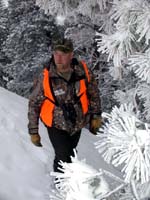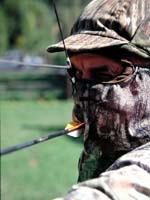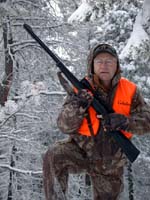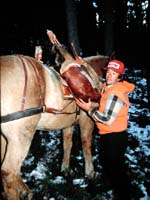
|
Features
|
|
|
|
Books
|
|
|
|
Fun & Games
|
|
|
|
Contact Us
|
|
|
John's Journal... Entry 175, Day 5
STEVE PUPPE ON ELK HUNTING IN THE BITTERROOT MOUNTAINS
Equipping The Elk Hunter
 EDITOR'S
NOTE: Steve Puppe of Hamilton, Montana, promotions
director for Knight Rifles and longtime avid hunter, lives on the edge
of the Bitterroot National Forest with its abundant elk, mule deer and
white-tailed deer.
EDITOR'S
NOTE: Steve Puppe of Hamilton, Montana, promotions
director for Knight Rifles and longtime avid hunter, lives on the edge
of the Bitterroot National Forest with its abundant elk, mule deer and
white-tailed deer.
QUESTION: Tell me about the decoy you use, how it works
and when you use it.
ANSWER: I use a Montana decoy. It's a silhouette-type decoy that folds
up, similar to a photo shield you use to throw light. It has a spring-loaded
frame and stakes. I use that when I'm calling to an elk. I fool their
ears with my call. I fool their noses by using the wind in my favor, and
I try to fool their eyes because they are looking for something. They
may stand at 70 or 80 yards and look. If they can't see anything, they
may leave. By using a decoy, you get the bull's attention, and he sees
the decoy before he spots the hunter. Often, I use a decoy when I'm guiding
several people. If I call for somebody, I want to take the attention away
from the hunter so the elk is focused on the decoy. It gives that hunter
the opportunity to draw his bow. If I'm hunting by myself, I put the decoy
beyond or behind me so he looks past my location. He comes to that sound
and sees the decoy. It's just like turkey hunting. His focusing on my
decoy gives me the opportunity to take a shot.
 QUESTION:
You climb a lot of mountains when you elk hunt. What kind of boots do
you recommend?
QUESTION:
You climb a lot of mountains when you elk hunt. What kind of boots do
you recommend?
ANSWER: You need a comfortable boot that fits your foot snug because you
don't want your feet to slide. I always wear Gore-Tex boots. You need
something that is waterproof because your feet get wet and soggy. And
wet socks cause you to get blisters. There's nothing worse than having
blisters on your feet. If you're planning an elk hunt, make sure to get
your boots long before the hunt so you can break them in good.
QUESTION: You also use a GPS. Tell me about when you've
used a GPS and how it's helped you.
ANSWER: The GPS is a great tool. Sometimes in the mountains you have trouble
picking up satellites, depending on where you are. If you get on top of
any ridge, generally you can pick up all the satellites to find your position.
But they really work good for finding your way in the dark when you can't
see any landmarks. You may have an elk down and are trying to pick it
up in the dark. A GPS leads you right to it. You need to have confidence
in your equipment. A lot of people don't.
 Once
I had an elk down. He was probably one and a half miles from the road.
It had gotten dark, and I was unfamiliar with that area. I knew there
was a road so I packed out the first load. I marked the elk with my GPS,
walked out the draw, ended up at a road and walked up the road a good
distance to get to the truck. When I reached my truck, I backed down to
the little draw where I was and followed it. When my GPS said I was there,
I looked around with my flashlight and I was five feet from the bull.
The GPS led me right to him. With zero visibility, it won't do you any
good to have a map if you can't see the terrain. Generally following a
stream down will take you somewhere. If you know a ridge is there, you
can get on the ridge, and the GPS will point you in the direction you
need to go. I mark a lot of things with my GPS. I mark my camp. I mark
my truck. If I find a honey hole that the elk frequent, I'll mark it.
Once
I had an elk down. He was probably one and a half miles from the road.
It had gotten dark, and I was unfamiliar with that area. I knew there
was a road so I packed out the first load. I marked the elk with my GPS,
walked out the draw, ended up at a road and walked up the road a good
distance to get to the truck. When I reached my truck, I backed down to
the little draw where I was and followed it. When my GPS said I was there,
I looked around with my flashlight and I was five feet from the bull.
The GPS led me right to him. With zero visibility, it won't do you any
good to have a map if you can't see the terrain. Generally following a
stream down will take you somewhere. If you know a ridge is there, you
can get on the ridge, and the GPS will point you in the direction you
need to go. I mark a lot of things with my GPS. I mark my camp. I mark
my truck. If I find a honey hole that the elk frequent, I'll mark it.
QUESTION: You said, "Eighty percent of hunters don't
get their elk." Why?
ANSWER: Hunter limitations. Many hunters are limited by their physical
endurance. To hunt elk, you must be physically and mentally able. Those
are the two limitations that keep most people from killing elk.
 QUESTION:
What are some physical limitations?
QUESTION:
What are some physical limitations?
ANSWER: Physical limitations can simply mean not being in good shape.
For instance, there may be a big meadow at the top of a mountain where
elk are feeding. If you have to walk one and a half miles and it takes
you five hours, you're not going to get there soon enough. To be there
at daylight, you have to leave at 2:00 in the morning. Then you're be
physically drained. Being in good physical condition will help you tremendously.
QUESTION: How does a guide pull a hunter up a hill mentally?
ANSWER: To help a hunter mentally, go at his pace and always encourage
him. Never discourage a hunter. Say, "Hey, it isn't that far up there.
It's only another half mile." The distance actually may be a mile, but
giving mental encouragement helps tremendously. I've never had somebody
who hasn't made it through a hunt.
QUESTION: So the secret to getting an elk is to get a
guide who can mentally help you to do that?
ANSWER: Oh, yes. As a guide, you must encourage the hunter. Instantly
you can tell their limitations. You can tell their physical capabilities
and their mental state-of-mind. By giving them encouragement, you can
generally put them in the right position to kill an elk.
To learn more about Knight Rifles, call (641) 856-2626, write them at Knight Rifles, Customer Service Dept., 21852 Hwy J46, Centerville, IA 52544, or visit the Web site www.knightrifles.com. You can contact Scott Boulanger, a dependable, expert elk guide in this section of Montana by writing him at P.O. Box 733, Darby, Montana, 59289. You can call him at (406) 821-0017, E-mail him at elkhunter@circlekbl.com, or visit his Web site www.circlekbl.com.
Check back each day this week for more about STEVE PUPPE ON ELK HUNTING IN THE BITTERROOT MOUNTAINS ...
Day 1 - Hunting A Fringe
Area
Day 2 - Road Hunting Elk
Day 3 - Hunting After Bugling Season
Day 4 - Why You Wait On An Elk
Day 5 - Equipping The Elk Hunter